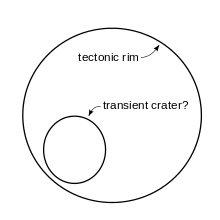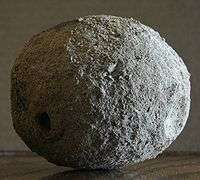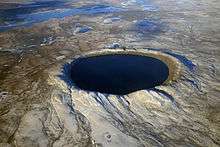Weaubleau structure
The Weaubleau structure is a probable meteorite impact site in western Missouri near the towns of Gerster, Iconium, Osceola, and Vista. It is believed to have been caused by a 1,200 feet (370 m) meteoroid between 335 and 340 million years ago[1] during the middle Mississippian Period (Latest Osagean to Earliest Meramecian). It is listed by the Impact Field Studies Group as a "probable" impact structure.[2]


The structure consists of an area of severe structural deformation and extensive brecciation that was poorly understood and had been thought to be the result of either thrusting over a dome[3] or a cryptoexplosive event.[4] A 12 mi (19 km) circular structure was discovered by geologist Kevin R. Evans through examination of digital elevation data.[5] The structure was originally called the Weaubleau-Osceola structure after Weaubleau Creek and Osceola. It is now known as the Weaubleau structure.
Because the site was covered by later Pennsylvanian Period sediments, and only partially exposed to erosion relatively recently, its structure is well preserved, and its age can be determined with fair accuracy. It is one of a series of known or suspected impact sites along the 38th parallel in the states of Illinois, Missouri, and Kansas. These 38th parallel structures are thought to possibly be the result of a serial impact, similar to that of comet Shoemaker-Levy 9 on Jupiter, an extremely unlikely event on Earth. The argument for a serial strike would be greatly strengthened if the ages of the other 38th parallel structures could be constrained to the same period as the Weaubleau structure.[6]
The Weaubleau structure is one of the fifty largest known impact craters on earth and the fourth largest in the United States. The three larger ones in the US either have been glaciated and buried (Manson crater), are under water (Chesapeake Bay crater), or have been subjected to orogeny (Beaverhead crater). Therefore, the Weaubleau structure is the largest exposed untectonized impact crater in the US.[5]
Round rocks

Long thought to be a glacial remnant, these conglomerate rocks are found in the area of the Weaubleau structure. They are nearly perfectly round, and are referred to locally simply as, "geodes," "round rocks","Missouri rock balls" or "Weaubleau eggs".[5]
It has been suggested that the round rocks are chert concretions or nodules. The round rocks may have formed when the impact threw shale clasts of Northview Formation away from the center of the crater and subsequent silica-saturated waters precipitated silica around the shale clasts. Formation of the round rocks is poorly understood and requires further research.[5]
References
- Miller, J.F., Evans, K.R., Rovey, C.W., II, Ausich, W.L., Bolyard, S.E., Davis, G.H., Ethington, R.L., Sandberg, C.A., Thompson, T.L., and Waters, J.A., Mixed-age echinoderms, conodonts, and other fossils used to date a meteorite impact, and implications for missing strata in the type Osagean (Mississippian) in Missouri, USA. Echinoderm Paleobiology, 2008, 53p.
- Rajmon, David (2009-07-01). "Impact database 2009.1". Retrieved 2009-08-25.
- Beveridge, T.R., 1949, The Geology of the Weaubleau quadrangle, Missouri [Ph.D. thesis]: Iowa City, State University of Iowa
- Snyder, F.G., Gerdemann, P.E., Hendricks, H.E., Williams, J.H., Wallace, G., and Martin, J.A., 1965, Cryptoexplosive structures in Missouri: Guidebook, 1965 Annual Meeting of the Geological Society of America: Missouri Geological Survey and Water Resources, Report of Investigations No. 30, 73 p.
- Evans, Kevin R.; Mickus, Kevin L.; Rovey, Charles W. III; & Davis, George H. (2003). Field Trip I: The Weaubleau Structure: Evidence of a Mississippian Meteorite Impact in Southwestern Missouri. Association of Missouri Geologists Field Trip Guidebook, No. 26, 50th Annual Meeting, pp. 1-30. Missouri Department of Natural Resources. PDF
- Dulin, Shannon; Elmore, R.D. (2008). Evans, Kevin R. (ed.). "The Sedimentary Record of Meteorite Impacts". Geological Society of America Special Paper. 437: 63.
Further reading
- Evans, K. R., Rovey, C. W., II, Mickus, K. L., Miller, J. F., Plymate, T., and Thomson, K. C. 2003. Weaubleau-Osceola structure, Missouri: deformation, event stratification, and shock metamorphism of a mid-Carboniferous impact site. Third International Conference on Large Meteorite Impacts, Nördlingen, Germany, August 5–7, 2003. Extended abstract from conference proceedings available online. PDF
- Evans, Kevin R.; Mickus, Kevin L.; Fagerlin, Stanley; Luczaj, John; Mantei, Erwin; Miller, James F.; Moeglin, Thomas; Pavlowsky, Robert T.; & Thomson, Kenneth C. 2004. Oblique Impact at Weaubleau-Osceola Structure, Missouri. Abstract online
- Space Today Online. The Planet Earth Today: Meteorite vs. Meteor, Meteoroid and Micrometeoroid. Retrieved November 27, 2004.

